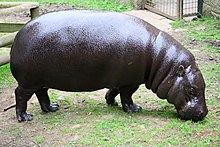
Back Dwergseekoei Afrikaans Choeropsis liberensis AN فرس النهر القزم Arabic فرس النهر القزم ARZ Choeropsis liberiensis AST Troskol (Hexaprotodon liberiensis) AVK Cırtdan begemot Azerbaijani Хипопотам джудже Bulgarian Dourvarc'h korr Breton Hipopòtam nan Catalan
| Pygmy hippopotamus | |
|---|---|

| |
| A pygmy hippopotamus at Edinburgh Zoo | |
| Scientific classification | |
| Domain: | Eukaryota |
| Kingdom: | Animalia |
| Phylum: | Chordata |
| Class: | Mammalia |
| Order: | Artiodactyla |
| Family: | Hippopotamidae |
| Subfamily: | Hippopotaminae |
| Genus: | Choeropsis Leidy, 1853 |
| Species: | C. liberiensis
|
| Binomial name | |
| Choeropsis liberiensis | |
| Subspecies | |
| |

| |
| Range map[1] | |
| Synonyms[1] | |
| |

The pygmy hippopotamus or pygmy hippo (Choeropsis liberiensis) is a small hippopotamid which is native to the forests and swamps of West Africa, primarily in Liberia, with small populations in Sierra Leone, Guinea, and Ivory Coast. It has been extirpated from Nigeria.[1]
The pygmy hippo is reclusive and nocturnal. It is one of only two extant species in the family Hippopotamidae, the other being its much larger relative, the common hippopotamus (Hippopotamus amphibius) or Nile hippopotamus. The pygmy hippopotamus displays many terrestrial adaptations, but like the common hippo, it is semiaquatic and relies on water to keep its skin moist and its body temperature cool. Behaviors such as mating and giving birth may occur in water or on land. The pygmy hippo is herbivorous, feeding on ferns, broad-leaved plants, grasses, and fruits it finds in the forests.
A rare nocturnal forest creature, the pygmy hippopotamus is a difficult animal to study in the wild. Pygmy hippos were unknown outside West Africa until the 19th century. Introduced to zoos in the early 20th century, they breed well in captivity and the vast majority of research is derived from zoo specimens.[4] The survival of the species in captivity is more assured than in the wild; in a 2015 assessment, the International Union for Conservation of Nature estimated that fewer than 2,500 pygmy hippos remain in the wild.[1]
Pygmy hippos are primarily threatened by loss of habitat, as forests are logged and converted to farm land, and are also vulnerable to poaching, hunting for bushmeat, natural predators, and war. Pygmy hippos are among the species illegally hunted for food in Liberia.
- ^ a b c d e Ransom, C.; Robinson, P.T.; Collen, B. (2015). "Choeropsis liberiensis". IUCN Red List of Threatened Species. 2015: e.T10032A18567171. doi:10.2305/IUCN.UK.2015-2.RLTS.T10032A18567171.en. Retrieved 27 August 2021.
- ^ "Appendices | CITES". cites.org. Retrieved 2022-01-14.
- ^ Cite error: The named reference
ASMwas invoked but never defined (see the help page). - ^ Stroman, H. R.; Slaughter, L. M. (January 1972). "The care and breeding of the Pygmy hippopotamus (Choeropsis liberiensis) in captivity". International Zoo Yearbook. 12 (1): 126–131. doi:10.1111/j.1748-1090.1972.tb02296.x.
© MMXXIII Rich X Search. We shall prevail. All rights reserved. Rich X Search
